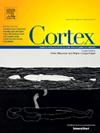等待冲动和主动抑制的神经回路映射与fMRI和TMS的趋同证据
IF 3.2
2区 心理学
Q1 BEHAVIORAL SCIENCES
引用次数: 0
摘要
背景和目的等待和停止是运动反应抑制的重要组成部分。等待冲动性传统上是在人类选择一系列反应时间任务中进行研究的。主动停止是一种与等待冲动相关的停止形式,它们之间相互作用的神经基质尚未得到很好的定义。方法我们进行了两项独立但分层的研究。在第一个实验中,我们使用功能性磁共振成像(fMRI),在N = 41名健康志愿者中,选择反应时间任务和新颖的主动停止任务,绘制了涉及等待冲动和主动停止的重叠神经回路。在第二项研究中,我们旨在提供机制和因果证据,证明连续θ波爆发刺激(cTBS;抑制性重复经颅磁刺激方案)影响等待冲动。我们招募了N = 51名健康的右撇子志愿者,采用单盲、随机、受试者间设计,将他们随机分配到刺激组(N = 26)和假手术组(N = 25),随后执行选择反应时间任务。结果在第一项研究中,我们发现;1. 由辅助前运动区和双侧脑岛前侧组成的共享神经网络是等待冲动和主动停止的基础。在额外目标起始延迟试验中,前额叶背内侧皮层和左额下回的活动与等待冲动性呈负相关。在第二项研究中,我们证明了使用cTBS使左侧额下回失活显著增加了选择反应时间任务中的等待冲动性。结论任务设计在评估运动反应抑制中的作用,以及左侧额下回完整性和相关神经回路在等待冲动性和主动停止中的作用。我们还利用多模态调查工具的聚合证据来解决不同形式冲动背后的因果神经区域。本文章由计算机程序翻译,如有差异,请以英文原文为准。
Neural circuit mapping of waiting impulsivity and proactive inhibition with convergent evidence from fMRI and TMS
Background and objectives
Waiting and stopping are essential and distinct elements of motor response inhibition. Waiting impulsivity has been traditionally studied in humans with choice serial reaction time tasks. Proactive stopping is one form of stopping relevant to waiting impulsivity and the neural substrates underlying their interaction are not well defined.
Methods
We conducted two separate, but hierarchical studies. In the first we used functional magnetic resonance imaging (fMRI), a choice reaction time task and a novel proactive stopping task, in N = 41 healthy volunteers to map the overlapping neural circuit involved in waiting impulsivity and proactive stopping. In the second study, we aimed to provide mechanistic and causal evidence that disruption of this circuit with continuous theta burst stimulation (cTBS; an inhibitory repetitive transcranial magnetic stimulation protocol) affected waiting impulsivity. We recruited N = 51 healthy, right-handed volunteers in a single-blind, randomized, between-subjects design who were randomly allocated to stimulation (N = 26) and sham (N = 25) groups and subsequently performed a choice reaction time task.
Results
In the first study, we showed; 1. a shared neural network comprising the pre- supplementary motor area and bilateral anterior insula underlying both waiting impulsivity and proactive stopping, and 2. activity in dorsomedial prefrontal cortex and left inferior frontal gyrus negatively correlated with waiting impulsivity in trials with additional target onset delay. In the second study, we demonstrated that inactivation of the left inferior frontal gyrus using cTBS significantly increased waiting impulsivity in a choice reaction time task.
Conclusions
Our findings highlight the relevance of task design in assessing motor response inhibition and the role of the left inferior frontal gyrus integrity and related neural circuitry in waiting impulsivity and proactive stopping. We also leverage the use of convergent evidence from multi-modal investigation tools in addressing the causal neural areas underlying distinct forms of impulsivity.
求助全文
通过发布文献求助,成功后即可免费获取论文全文。
去求助
来源期刊

Cortex
医学-行为科学
CiteScore
7.00
自引率
5.60%
发文量
250
审稿时长
74 days
期刊介绍:
CORTEX is an international journal devoted to the study of cognition and of the relationship between the nervous system and mental processes, particularly as these are reflected in the behaviour of patients with acquired brain lesions, normal volunteers, children with typical and atypical development, and in the activation of brain regions and systems as recorded by functional neuroimaging techniques. It was founded in 1964 by Ennio De Renzi.
 求助内容:
求助内容: 应助结果提醒方式:
应助结果提醒方式:


